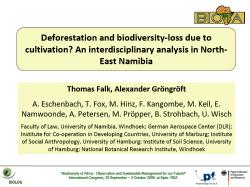|
|
|
 |
|
|
Presentation
< back to presentation overview
| Details of the presentation |
| Presentation |
Oral presentation |
| Title |
Deforestation and biodiversity-loss due to cultivation? An interdisciplinary analysis in North-East Namibia
|
| PDF Download |
 Download PDF (Filesize 3.7 MB)
Download PDF (Filesize 3.7 MB)

|
| Short title |
Landuse patterns of Kavango
|
| Author(s) |
Falk, T.(3); Gröngröft, A.(1); Hecht, J.(3); Hinz, M.(4); Kangombe, F.(5); Keil, M.(6); Petersen, A.(1); Pröpper, M.(2); Strohbach, B.(5); Wisch, U.(1)
|
| Presenting author |
Gröngröft, A.; Falk, T.
|
| Institution(s) |
(1) Institute of Soil Science, University of Hamburg; (2) Institute of Social Anthropology, University of Hamburg; (3) Institute for Co-operation in Developing Countries University of Marburg; (4) Faculty of Law, University of Namibia, Windhoek; (5) National Botanical Research Institute Namibia; (6) German Aerospace Center (DLR)
|
| Keywords |
Kavango, deforestation, cultivation, communal land management, patterns of diversity, soil nutrients, cultural perceptions of biodiversity
|
| Abstract |
As in many regions of the world land-clearing for agricultural purposes is the main threat for Namibian forests such as Kavango woodlands and a main reason for the loss of local biodiversity. Over the past decades the Kavango region in North-East Namibia has experienced a strong population growth. Three quarters of the rural population depend on subsistence natural resource use such as dryland rain-fed cultivation. Livelihoods of subsistence farmers are vulnerable due to unpredictable precipitation and low nutrition values of the soil. This study aims to analyse the local system of subsistence farming and use of natural resources in order to enable an evaluation of biodiversity loss of the region and to predict the trends for future action.
In the presentation the interdisciplinary BIOTA Kavango working cluster presents joint findings on drivers and causes of human-biodiversity impact as well as motives and perceptions for behavior. We will link soil science results on agricultural impact on soil compositions to botanical observations on species occurrence, remote sensing data on change detection, anthropological findings on local biodiversity knowledge, and institutional analysis regarding statutory and customary use regulations.
|
| Congress Topic |
Land use, impact and value
|
| Topic No. |
3.6 |
| Notes |
---
|
| Ref. No. |
573 |
|
|
|
